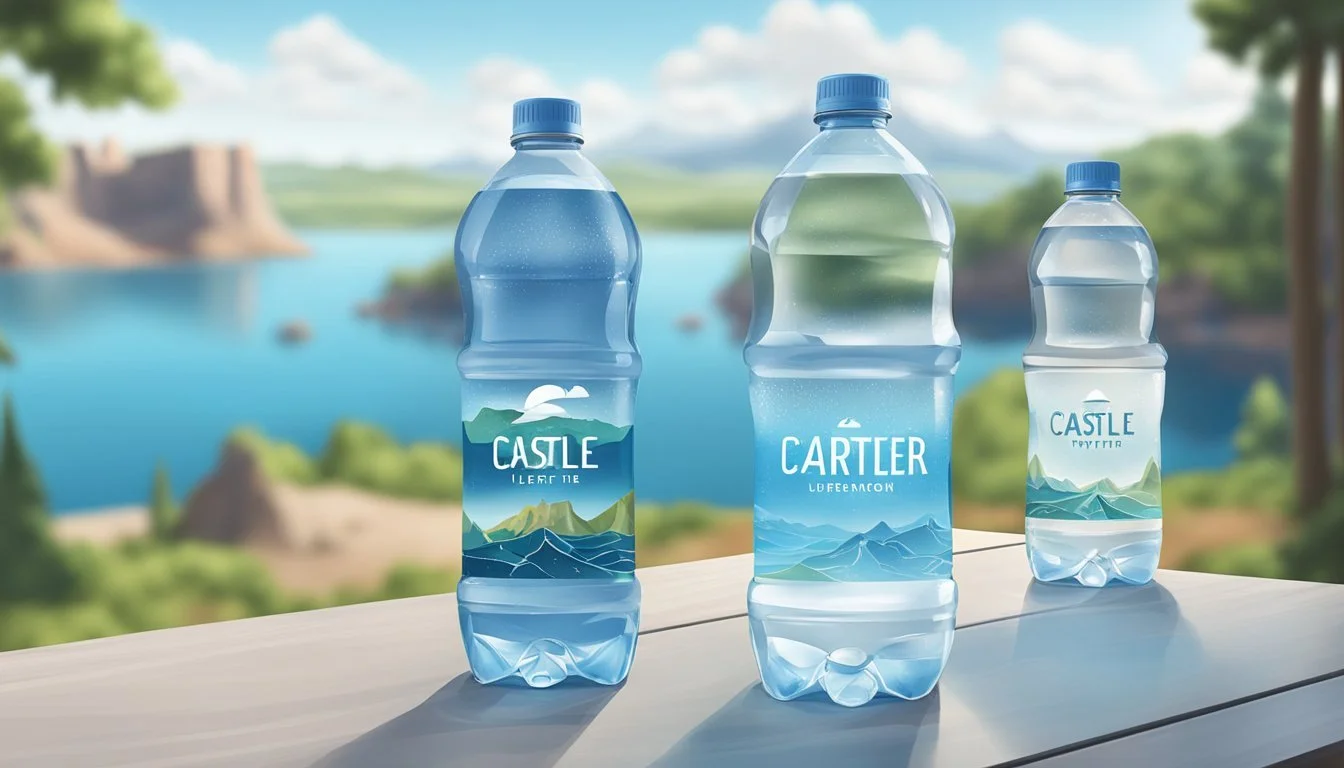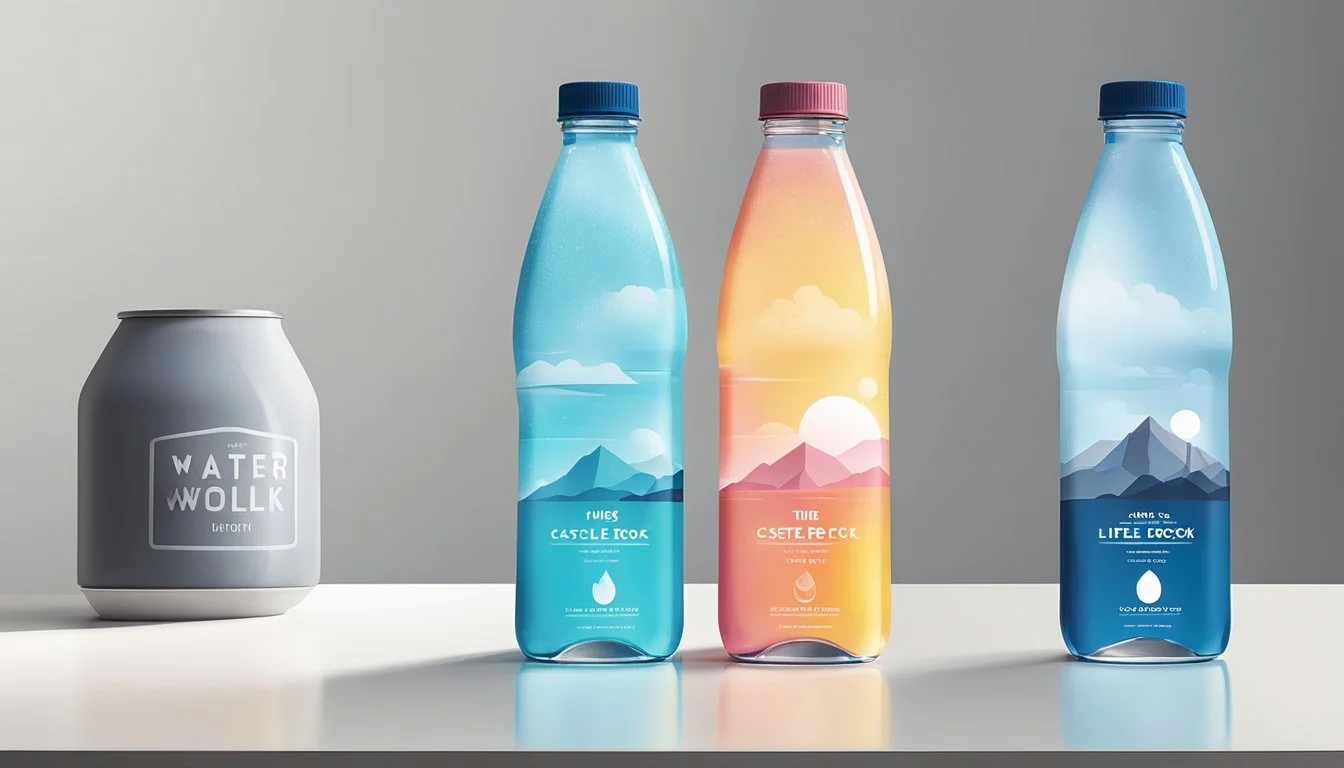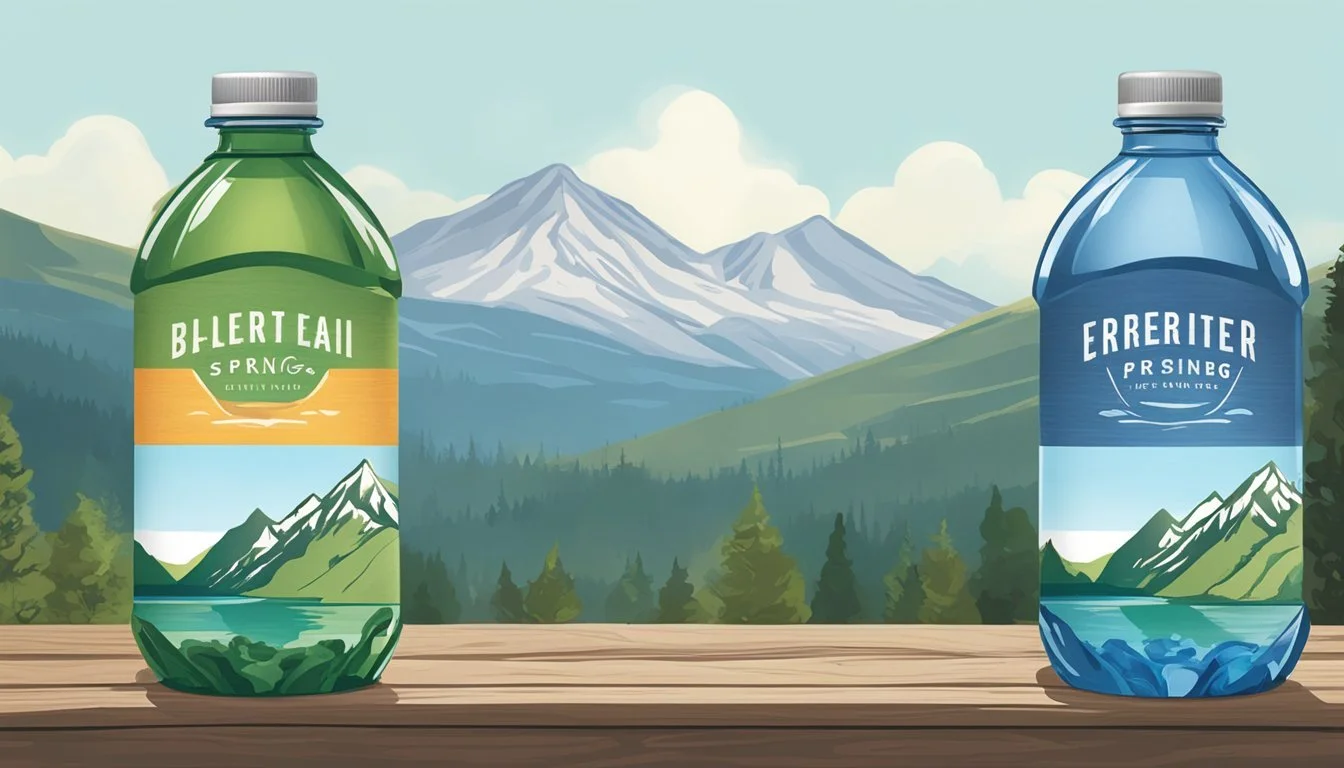LIFEWTR vs. Castle Rock
A Comprehensive Comparison
LIFEWTR and Castle Rock are two prominent names in the bottled water market today. Both brands promise high-quality hydration, but their approaches differ significantly. For those seeking a mineral-rich, eco-friendly option, Castle Rock stands out with its pristine source from Northern California's Mount Shasta. Meanwhile, LIFEWTR caters to consumers looking for pH-balanced, artistically inspired hydration.
Castle Rock prides itself on offering natural spring water with a commitment to sustainability. Its water is renowned for its crisp taste and purity, sourced directly from protected springs. The brand ensures minimal environmental impact by utilizing eco-friendly bottles. This dedication to the environment may appeal to individuals who prioritize both health and ecological consciousness in their purchasing decisions.
On the other hand, LIFEWTR offers purified water with balanced pH levels that range typically from 6.4 to 7.4. Known for its sleek, art-driven packaging, LIFEWTR also focuses on supporting art and creativity, appealing to aesthetically minded consumers. While both brands offer distinct benefits, the choice between them ultimately depends on personal values and taste preferences.
Understanding Bottled Water
Bottled water is a convenient hydration option, often categorized by type and subject to specific regulatory standards. Key factors include its source, purification process, and compliance with health regulations.
Definition and Types of Bottled Water
Bottled water can originate from various sources and undergo different processing techniques.
Spring water comes from an underground formation and flows naturally to the surface. This type often contains natural minerals.
Purified water is typically sourced from municipal tap water but is treated to remove any impurities, resulting in high purity levels.
Mineral water is drawn from a mineral spring and contains specific amounts of minerals like calcium, magnesium, and sodium, which must stay constant.
Each type of water provides distinct taste and potential health benefits, influenced by its mineral content and processing methods.
Regulations and Standards
In the United States, bottled water is regulated by the FDA (Food and Drug Administration), which enforces stringent standards to ensure safety and quality.
Bottled waters must meet Good Manufacturing Practice (GMP) standards.
Labels must accurately reflect the content, including mineral composition and source.
Bottled water often adheres to more rigorous standards than tap water.
FDA regulations stipulate that bottled water must be processed, packaged, transported, and stored under sanitary conditions. Regular testing for contaminants like bacteria, chlorine, fluoride, and heavy metals is mandatory. These measures help uphold consistency and safety across all bottled water products.
Overview of LIFEWTR and Castle Rock
LIFEWTR and Castle Rock offer unique attributes in the bottled water market, from their brand histories and ownership to their water sources and production methods.
Brand Histories and Ownership
LIFEWTR is owned by PepsiCo, a global leader in beverages and snacks. It was launched in 2017 as a premium bottled water brand. The brand aims to combine hydration with inspiration, showcasing designs by artists on its bottles. This artistic focus sets LIFEWTR apart from other bottled water brands.
Castle Rock is a smaller, independent brand with a focus on sustainability. Founded in the early 2000s, it sources its water from pristine regions in Northern California. The brand is committed to environmental responsibility, using eco-friendly packaging and supporting conservation efforts.
Source and Production
LIFEWTR sources its water from various underground springs across the United States. It undergoes a rigorous filtration process to ensure purity and consistency. The water is then enhanced with electrolytes for taste, resulting in a balanced pH level, typically between 6.4 to 7.4. This makes it slightly acidic to neutral.
Castle Rock sources its water from a single, protected underground spring in Castle Rock, Northern California. The water is naturally filtered through volcanic rock, providing it with a unique mineral profile. Due to its natural filtration, the water typically has a pH level around 7.6, making it slightly alkaline. The focus on a single source and minimal processing emphasizes its purity and natural taste.
Brand Ownership Water Source pH Level LIFEWTR PepsiCo Various underground springs (USA) 6.4 - 7.4 Castle Rock Independent Castle Rock, Northern California ~7.6
Both brands highlight distinct features, from corporate backing and creative packaging to environmental sustainability and unique filtration processes.
Health and Hydration
Both LIFEWTR and Castle Rock Water aim to provide not just hydration, but also essential minerals and balanced pH levels to support overall health.
Electrolytes and Mineral Content
LIFEWTR is known for its infusion of electrolytes, which include calcium chloride, magnesium sulfate, and potassium bicarbonate. These electrolytes help maintain the body's hydration levels and support muscle function. LIFEWTR contains a moderate amount of these minerals, which enhance the taste and potentially offer some added health benefits.
Castle Rock Water, sourced from a natural spring, boasts a naturally occurring blend of calcium, magnesium, and other trace minerals. The water’s mineral content is largely dependent on the source's geology. These minerals play vital roles in bone health, muscle function, and overall metabolic processes.
Comparison Table:
Brand Calcium (mg/L) Magnesium (mg/L) Potassium (mg/L) LIFEWTR 3.8 1.2 0.7 Castle Rock 4.5 1.6 0.8
The slightly higher mineral content in Castle Rock Water may offer additional nutritional benefits compared to LIFEWTR.
pH Levels and Water Quality
LIFEWTR has a balanced pH level ranging from 6.4 to 7.4, which helps maintain the body's natural pH balance. The water is purified using a rigorous process that ensures its quality and cleanliness. This balanced pH level is considered neutral and suitable for regular consumption.
Castle Rock Water features a naturally alkaline pH typically around 7.6 to 8.2. Higher pH levels may help to neutralize acidity in the body, making it a preferred choice for those seeking alkaline hydration options. The natural filtration through volcanic rock and other geological formations ensures that Castle Rock maintains high levels of purity without the need for extensive artificial processing.
Both water brands focus on delivering a product that supports hydration and health through their unique compositions and purification methods.
Taste Profile
LIFEWTR and Castle Rock offer distinct taste experiences influenced by their mineral content and sourcing. Below, we explore the key aspects that contribute to their unique taste profiles.
Factors Influencing Taste
Mineral Content: The presence of minerals such as calcium, magnesium, and potassium can affect water's taste. LIFEWTR is known for maintaining a balanced mineral content, which gives it a crisp and refreshing taste. On the other hand, Castle Rock, a spring water, contains natural minerals absorbed as it flows through rock formations, providing a distinct, clean taste.
pH Levels: The pH level significantly influences taste. LIFEWTR typically has a pH range of 6.4 to 7.4, making it slightly acidic to neutral. Castle Rock often maintains a more alkaline pH, contributing to a subtly different mouthfeel.
Source of Water: LIFEWTR is purified using a multi-stage filtration process, while Castle Rock is sourced directly from springs in the Sierra Nevada. This difference in sourcing impacts taste, with Castle Rock offering an untouched, natural quality compared to LIFEWTR's clean and filtered sensation.
Taste Comparison
LIFEWTR: Consumers report that LIFEWTR tastes clean and smooth, with a balanced flavor that avoids any specific mineral aftertaste. Its slightly acidic to neutral pH harmonizes well with a variety of palates, making it a versatile choice for many.
Castle Rock: Castle Rock is often described as having a crisp and refreshing taste, akin to the experience of drinking directly from a mountain spring. The natural minerals provide a subtle but noticeable depth to its flavor, which some may liken to a slight sweetness or earthy undertone.
Personal Preference: Taste is subjective and can vary based on personal preference. Those who prefer a clean, straightforward taste might lean towards LIFEWTR. In contrast, individuals seeking a more natural and complex flavor profile may find Castle Rock more appealing.
Both LIFEWTR and Castle Rock offer unique taste experiences shaped by their mineral content, pH levels, and sources. The choice between them largely depends on personal taste preferences.
Environmental and Ethical Considerations
LIFEWTR and Castle Rock are two bottled water brands that have distinct environmental and ethical practices. This section reviews their sustainability efforts and packaging choices.
Sustainability Practices
LIFEWTR focuses on sustainability by using locally-sourced water and minimizing their carbon footprint during production. They partner with Recycle Across America to promote recycling education. Their commitment includes using sustainably managed resources and offsetting emissions through various environmental projects.
Castle Rock sources water from natural springs in pristine wilderness areas, emphasizing the preservation of these ecosystems. They employ renewable energy in their bottling plants, aiming to reduce their environmental impact. Castle Rock also supports water conservation projects, contributing to the long-term sustainability of natural water sources.
Packaging and Recycling
LIFEWTR's packaging is designed to be 100% recyclable, using BPA-free plastic. They emphasize artistic bottle designs that appeal to consumers, but more importantly, encourage the recycling of bottles. This effort aligns with their partnership with Recycle Across America to boost recycling rates nationwide.
Castle Rock opts for environmentally friendly packaging, using glass bottles and post-consumer recycled plastic. Their glass bottles are not only recyclable but also reusable, catering to environmentally conscious consumers. The company actively promotes the reduction of single-use plastics and supports initiatives for widespread recycling and responsible disposal of packaging materials.
Imperatives for Choosing Bottled Water
When selecting bottled water, it is crucial to consider factors such as purity and contaminants, as well as the balance between convenience and environmental impact.
Assessing Water Purity and Contaminants
Evaluating the purity of bottled water ensures that it is free from harmful substances. Contaminants like heavy metals, bacteria, additives, and BPA can affect health. Testing for these elements can help in selecting a safer option.
Pure bottled water should have low levels of fluoride and chloride, with clear labeling of its source. Brands like LIFEWTR often highlight their filtration processes, ensuring a higher level of transparency.
Convenience vs. Environmental Impact
The convenience of bottled water often clashes with concerns about sustainability. Single-use plastic bottles contribute significantly to environmental pollution. Consumers should consider the recyclability of the bottles, such as LIFEWTR’s commitment to using 100% recyclable plastic.
Choosing water packaged in eco-friendly materials or opting for bulk purchasing can reduce individual plastic waste. Balancing ease of access with responsible consumption is key to minimizing the environmental footprint without compromising convenience.
Comparative Analysis
The comparative analysis between LIFEWTR and Castle Rock bottled waters addresses the cost, availability, consumer preferences, and expert recommendations, providing a comprehensive view of each brand's strengths and areas for improvement.
Cost
When evaluating the cost, LIFEWTR typically falls in the mid to high price range for bottled waters, often marketed as a premium product. On the other hand, Castle Rock is also positioned as a premium brand but sometimes slightly less expensive than LIFEWTR.
Consumers can expect to pay around $1.50 to $2.00 for a 1-liter bottle of LIFEWTR. Castle Rock's pricing is similar, though it can occasionally be found slightly cheaper, especially in bulk purchases. Promotional discounts and bulk buying options can significantly affect the pricing for both brands.
Availability
LIFEWTR enjoys wide availability, easily found in major supermarkets, convenience stores, and online marketplaces. This extensive distribution network ensures that consumers can purchase LIFEWTR without much difficulty regardless of their location.
In contrast, Castle Rock has a more regionalized distribution, primarily available on the West Coast and select areas nationwide. Availability in local stores can be hit or miss outside of its regional stronghold, making it less accessible compared to LIFEWTR. However, online retailers do provide a convenient way to purchase Castle Rock for those living outside its primary market areas.
Consumer Preferences
Consumer preferences can vary, but LIFEWTR often wins favor due to its branding and flavor profile. The brand's focus on combining art and hydration attracts a younger, urban demographic.
Castle Rock, with its commitment to sustainability and natural sourcing, appeals to consumers who prioritize environmental considerations. Those who prefer a crisp and clean taste profile also tend to favor Castle Rock. Surveys and taste tests can sometimes place both brands on par, with taste being subjective to personal preferences.
Expert Recommendations
Experts generally recommend both brands for their unique qualities. LIFEWTR is praised for its focus on purity, with pH levels maintained between 6.4 to 7.4, which aligns closely with the body's natural pH.
Castle Rock is often highlighted for its natural spring sourcing and sustainable practices, including the use of environmentally-friendly packaging. This ethos resonates well with eco-conscious consumers and experts alike.
Overall, experts suggest choosing based on individual preferences for taste, cost, and availability. Both LIFEWTR and Castle Rock have carved out their niches, appealing to different segments of the market.
Concluding Thoughts
LIFEWTR and Castle Rock both aim to provide excellent hydration but cater to slightly different preferences.
Taste plays a significant role in choosing bottled water. LIFEWTR is often praised for its crisp, clean taste. Castle Rock, sourced from mountain springs, offers a natural and refreshing flavor.
Health considerations are crucial. LIFEWTR boasts a balanced pH level, typically around 6.4 to 7.4. Castle Rock promotes natural minerals beneficial for body functions. Both ensure quality and safety standards.
Sustainability is an increasing concern. LIFEWTR uses recyclable bottles, highlighting its environmental responsibility. Castle Rock, with its source in protected spring areas, emphasizes minimal environmental impact.
In terms of hydration, both brands provide efficient hydration solutions. They meet the needs of active individuals and those seeking everyday hydration.
Ultimately, choosing between LIFEWTR and Castle Rock depends on personal preference for taste, health benefits, and sustainability practices. Both offer high-quality bottled water options, making them strong contenders in the market.
More About LIFEWTR
Icelandic Glacial vs LIFEWTR: Which Bottled Water is Better?
LIFEWTR vs Kirkland Signature: Which Bottled Water is Better?
LIFEWTR vs Mountain Valley Spring Water: Which Bottled Water is Better?
LIFEWTR vs Richard's Rainwater: Which Bottled Water is Better?
LIFEWTR vs Whole Foods Italian Still Mineral water: Which Bottled Water is Better?
More About Castle Rock
Aqua Carpatica vs Castle Rock: Which Bottled Water is Better?
Castle Rock vs Cascade Mountain: Which Bottled Water is Better?
Castle Rock vs Crystal Geyser: Which Bottled Water is Better?
Castle Rock vs Hawaii Volcanic: Which Bottled Water is Better?
Castle Rock vs Hawaiian Springs: Which Bottled Water is Better?
Castle Rock vs Kirkland Signature: Which Bottled Water is Better?
Castle Rock vs Purely Sedona: Which Bottled Water is Better?
Castle Rock vs Richard's Rainwater: Which Bottled Water is Better?
Castle Rock vs Solan de Cabras: Which Bottled Water is Better?
Castle Rock vs Talking Rain AQA: Which Bottled Water is Better?
Castle Rock vs Whole Foods 365: Which Bottled Water is Better?
Castle Rock vs Whole Foods Italian Still Mineral water: Which Bottled Water is Better?
Core Hydration vs Castle Rock: Which Bottled Water is Better?
Icelandic Glacial vs Castle Rock: Which Bottled Water is Better?
Mountain Valley Spring Water vs Castle Rock: Which Bottled Water is Better?
Nestle Pure Life vs Castle Rock: Which Bottled Water is Better?
Poland Spring vs Castle Rock: Which Bottled Water is Better?
San Pellegrino vs Castle Rock: Which Bottled Water is Better?





